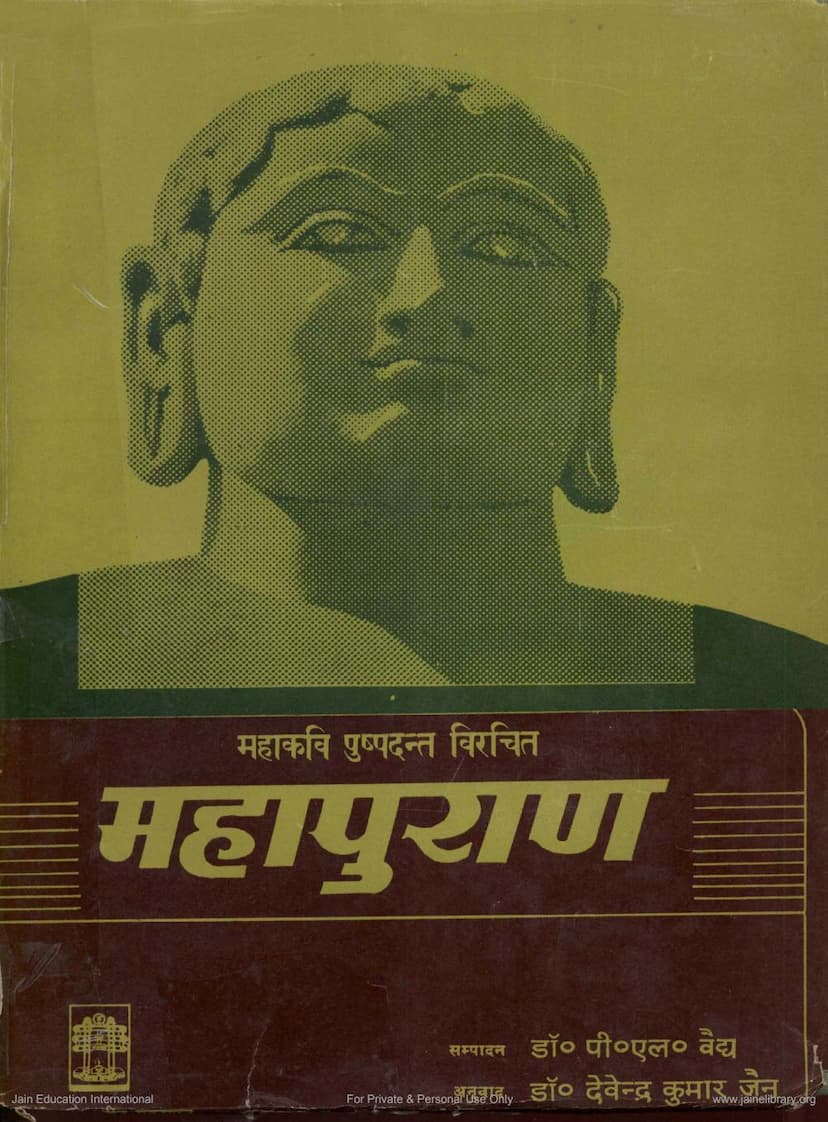Mahapurana Part 1
Added to library: September 2, 2025

Summary
This is a comprehensive summary of the provided Jain text, Mahapurana Part 1, authored by Pushpadanta and edited by P. L. Vaidya.
Title: Mahapurana Part 1 (Also known as Trishashti Mahapurusha Gunaalankara) Author: Mahakavi Pushpadanta Editor: Dr. P. L. Vaidya Publisher: Bharatiya Gyanpith Language: Apabhramsa (with Hindi translation and introduction) Volume: Part 1 (Nābheyacar u Pūrvārdha - First part of the life of Rishabha)
Overview:
Mahapurana Part 1 is the earliest and largest of the three known works of the renowned Apabhramsa poet Pushpadanta. This monumental epic, written in the 10th century CE, provides a vibrant reflection of Indian culture during that period. It masterfully blends spiritual and secular themes, weaving together narratives of great personalities with descriptions of nature, human psychology, and the intricate relationship between religion and life. The text, written in Apabhramsa, showcases the poet's immense talent, demonstrating that poetic genius transcends regional and linguistic limitations.
Key Content and Significance:
- Apabhramsa Literature: This work is considered a foundational text in Apabhramsa literature, a crucial link in the historical development of modern Indian languages. Pushpadanta's refined and elegant language rivals the sweetness of Sanskrit poetry.
- Lives of Great Men (Shalaka Purushas): The Mahapurana, as the title suggests, is a compilation of the lives of the sixty-three illustrious beings (Shalaka Purushas) in Jain tradition. This volume, Part 1, focuses primarily on the life of Nābheya, who is Lord Rishabha, the first Tirthankara, and also details the early life of Bharata, the first Chakravartin (universal monarch).
- Rishabha's Life (Nābheya Charitra): The narrative begins with the description of Lord Rishabha's birth, his celestial anointing, his upbringing, his marriage to Yashovati and Sunanda, and his eventual renunciation. The text highlights Rishabha's role in establishing the 'karma-bhumi' culture after the cessation of the 'bhoga-bhumi' (era of enjoyment).
- Bharata Chakravartin: The volume also includes significant portions detailing Bharata's life, his lineage, his efforts to establish the 'Brahmana' order, and his military conquests that led to his becoming a Chakravartin. The complex relationship and eventual conflict between Bharata and his brother Bahubali is a key narrative thread, showcasing themes of dharma, duty, and renunciation.
- Cultural Reflection: The Mahapurana serves as a pristine mirror reflecting 10th-century Indian culture. It portrays the intricate interplay of devotion and worldly pursuits, the depiction of human emotions, and the harmonious blend of poetry and scriptural principles.
- Poetic Excellence: Pushpadanta's mastery over the Apabhramsa language is evident in its sublime vocabulary and captivating style, which rivals the sweetness of Sanskrit poetry. The text's composition process, the poet's own philosophical musings, his critique of societal flaws, and his deep devotion to Jain principles are also discussed.
- Historical Context: The text is situated in the capital of the Rashtrakuta dynasty, Manyakheta (modern Malkhed), where Pushpadanta resided and composed this epic, highlighting the patronage of arts and literature during that era.
- Editorial and Translation Efforts: The publication by Bharatiya Gyanpith, featuring the critical text edited by Dr. P. L. Vaidya and a simple yet comprehensive Hindi translation by Dr. Devendra Kumar Jain, makes this significant work accessible to a wider audience of scholars and enthusiasts of Jain literature.
Structure of Volume 1:
This first volume is planned to cover the Pūrvārdha (first half) of the Rishabha Charitra, comprising the initial thirty-seven Sandhis (chapters) out of a total of 102 for the entire Mahapurana.
Key Themes Explored:
- The Cycle of Birth and Liberation: The text implicitly and explicitly deals with the soul's journey through various forms of existence, the cycle of karma, and the ultimate path to liberation.
- Dharma and Karma: The narratives illustrate the principles of dharma (righteousness) and karma, showing how actions lead to consequences and how virtuous deeds lead to spiritual progress.
- Renunciation vs. Worldly Life: The lives of Rishabha and Bharata, in particular, explore the tension between worldly power and spiritual renunciation, showcasing the higher path of detachment.
- The Ideal Ruler and the Ideal Monk: The stories of Bharata and Rishabha, respectively, present archetypes of the ideal king and the ideal monk, highlighting their respective virtues and duties.
- Critique of Society: Pushpadanta, through his characters and narratives, subtly critiques the societal norms, hypocrisy, and the pursuit of fleeting pleasures.
In essence, Mahapurana Part 1 is a rich tapestry of Jain teachings, cultural history, and poetic brilliance, primarily focusing on the foundational life story of Lord Rishabha and his impact on the world, alongside the chronicle of the first Chakravartin, Bharata.